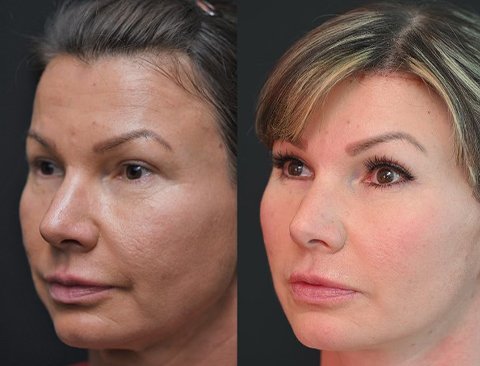Treatment Overview
Jawline Contouring with Neck Lift is a comprehensive facial rejuvenation procedure that enhances the jawline while simultaneously lifting and tightening the neck. This combined approach addresses sagging skin, excess fat, and weak muscle tone, creating a more defined and youthful lower face. In Korea, the procedure is performed using advanced surgical techniques and precise preoperative planning to achieve natural harmony between the jawline and neck.
Purpose & Benefits
The surgery provides structural and aesthetic improvement to the lower face:
- Enhances jawline definition and reduces jowls
- Smooths and tightens neck skin for a youthful profile
- Corrects mild to moderate sagging and muscle laxity
- Restores facial balance and proportion
- Offers longer-lasting results than isolated treatments
Ideal Candidates
You may be an ideal candidate if you:
- Have sagging or weak jawline and neck contours
- Desire a combined, single-stage procedure for efficiency
- Are in good overall health and non-smoker
- Have realistic expectations for natural results
- Prefer long-term improvement over temporary solutions
Possible Risks & Complications
As with any surgery, risks include swelling, bruising, infection, numbness, asymmetry, scarring, and rare nerve injury. Experienced Korean surgeons minimize these risks through advanced techniques and careful monitoring.
Surgical Techniques Used
The procedure combines jawline contouring and neck lift techniques:
- Jawline contouring may involve osteotomy, reduction, or augmentation for precise shape.
- Neck lift includes SMAS or platysma tightening and removal of excess skin.
- Small, strategically placed incisions minimize visible scars.
- Korean surgeons may incorporate endoscopic assistance or liposuction for enhanced contouring and precision.
Recovery & Aftercare
Recovery generally takes 10–14 days before returning to normal activities, with swelling and bruising subsiding gradually over weeks.
Aftercare recommendations include:
- Wearing a compression garment for support
- Keeping the head elevated to reduce swelling
- Avoiding strenuous activity for 3–4 weeks
- Following scar care and massage routines as advised
- Attending regular follow-up visits to ensure symmetry
Results & Longevity
Initial results are visible immediately, while final outcomes appear after 2–3 months as swelling resolves. With proper maintenance, results can last 10–15 years, providing a natural, long-lasting enhancement to the lower face.
Treatment Process in Korea
The process starts with a comprehensive consultation and 3D imaging to assess the jawline and neck structure. Surgeons develop a customized surgical plan based on the patient’s anatomy and aesthetic goals. On surgery day, general anesthesia or sedation is administered, and the procedure typically lasts 3–4 hours. After surgery, Korean clinics provide advanced recovery support, including LED therapy, lymphatic massage, and gentle facial exercises to promote healing.
Cost Range
The cost of Jawline Contouring with Neck Lift in Korea generally ranges from ₩12,000,000 to ₩20,000,000 KRW (approximately $9,000 – $15,200 USD) depending on the surgeon’s expertise, clinic facilities, and complexity of the procedure.
| Service Component | Cost Range (KRW) | Approx. USD |
|---|---|---|
| Consultation & Imaging | ₩100,000 – ₩300,000 | $75 – $230 |
| Surgical Fee | ₩11,000,000 – ₩18,000,000 | $8,300 – $13,700 |
| Anesthesia & Facility Fees | ₩500,000 – ₩800,000 | $380 – $610 |
| Postoperative Care | ₩200,000 – ₩400,000 | $150 – $305 |
Popular Clinics in Korea
- ID Hospital: Known for advanced jawline contouring and neck lifting techniques.
- Banobagi Plastic Surgery: Specializes in comprehensive lower face rejuvenation.
- JW Plastic Surgery: Offers scar-minimizing, natural-looking combined procedures.
- View Plastic Surgery: Popular among international patients for premium results.
- The Plus Plastic Surgery: Focuses on harmonious jawline and neck balance with structural lifting.




